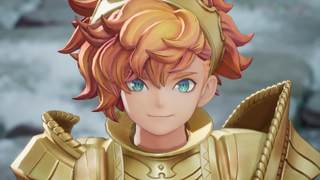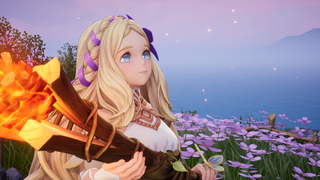Visions of Mana is exactly what it should be: mid-budget RPG comfort food
For a series that started as an action-based Final Fantasy spinoff, this adventure revels in its RPG roots.

It took an entire hour for Visions of Mana to click with me.
I’ve poured a lot of time into Square Enix action RPGs lately. Between Final Fantasy 16, Final Fantasy 7 Rebirth, and even 2020’s Trials of Mana, I expected Visions of Mana to play similarly when I demoed it this month. Yet what I saw was the opposite: Combat is slow-paced, even though enemies can bombard you with rapid attacks marked by AoEs. There’s no combo system, despite the fact that Trials of Mana, a 3D remake of a 1995 Super Famicom game, had one. I struggled as I initially tried to button mash my way to victory, which only slowly whittled away at the HP bars of basic enemies at best.
I love the older Mana games, but the combat felt so off at first. Could Visions of Mana be straight-up bad? Fearing the answer to that question, I took a few minutes to dig into the game’s menus and analyze all the tools at my disposal. That's when I turned the corner.
What Visions of Mana lacks in intensity it makes up for with a rich variety of combat options. I couldn't chain light and heavy attacks together like in most action games, but tapping or holding down those buttons triggers unique moves of varying offensive and defensive capabilities. Each character can equip cooldown abilities, which are perfect for clearing basic encounters in a flash. By the time I reached the demo’s boss I was swapping between my party members to unleash an onslaught of magic that applied buffs, debuffs, and dealt serious damage. Within 60 minutes, I went from feeling like a weakling to a swaggering adventurer despite only gaining a level or two in the process.
I should've known not to panic: Abandoning what I knew from the series’ previous game is the quintessential Mana experience.
Out on the open world again
The Mana games have never been afraid to get a bit weird, so it was almost surreal to start Visions of Mana in a wide open field that structurally resembles many typical modern RPGs. Within five minutes I saw hidden treasure chests, side quests that pointed me towards optional battles, and collectibles I could reach with some light platforming.
It's immediately more exploration than I remember from many previous Mana games, but also a bit pedestrian compared to the series’ typically experimental design. More than once I thought "this feels like Genshin Impact without the live service parts."
The biggest gaming news, reviews and hardware deals
Keep up to date with the most important stories and the best deals, as picked by the PC Gamer team.
That’s not an inherently bad approach in my book, and Visions of Mana does appear to be using the form to encourage exploration. I got in over my head against some powerful enemies after I acclimated to the combat, a lively moment coming from Trials of Mana’s tepid difficulty. There also appeared to be secrets that you’d have to return to later in the game to unlock, which harkens back to the world design of classic RPGs like Dragon Quest. I could do without the canned voiced lines that repeated every time I gathered certain items, but even that made me vaguely nostalgic for the B-tier PS2 RPGs I played in my teenage years.




That said, it’s that crunchy RPG-y core that really makes me excited for the combat and exploration in the full game.
Visions of Mana uses a class system, but instead of picking from a pool of predefined classes to assign party members, I was pleased to see that each character had their own unique class options to choose from. The protagonist initially starts off wielding a greatsword that delivers especially weighty attacks. I could change him to the Aegis class to give him a slightly faster spear and a huge shield. This led to a very defensive playstyle, even turning one of his former attacks into a dedicated block command.
While I didn’t have a ton of toys to play with, I saw ample potential for customization. Each character has four dedicated magic spell slots, and these were all interchangeable regardless of class. Debuffs, healing over time, elemental attacks, all the classic RPG fundamentals were there. I didn’t have a ton of options in terms of customizing my loadout, but it was a nice amount of variety considering this demo took place in the early game.
An hour wasn't nearly enough time to experiment with the available systems and hone in on my personal playstyle. But with the way modern RPGs like Final Fantasy have streamlined their systems, Visions of Mana struck me as steadfastly holding true to the RPG sensibilities of the '90s and early 2000s with some modern flourishes.
It doesn’t push boundaries, and that’s the point

Visions of Mana isn't going to change the world, or even RPGs, when it launches. It reads as a modestly budgeted game for people who remember when Squaresoft and Enix were two different companies. But in 2024, I think that approach is well worth celebrating.
If you’ve paid attention to game industry news lately, you know that big budget game development has become unsustainable. Horrific layoffs have plagued the industry and expensive games need to sell many millions of copies just to break even. Meanwhile, Visions of Mana’s predecessor Trials of Mana was considered a massive success. Despite “only” selling a million, Square Enix stated in its 2020 Financial Results Briefing that the game “significantly surpassed our initial expectations.”
Square Enix is no stranger to “AA” games, but Visions of Mana comes at an inflection point for big game publishers. It shows the value of games without state-of-the-art production values that don't need to be all things to all people. It looks good, it plays well, and I’m okay with less spectacle. Especially if it means the people making it can actually keep their jobs.
Most Popular

